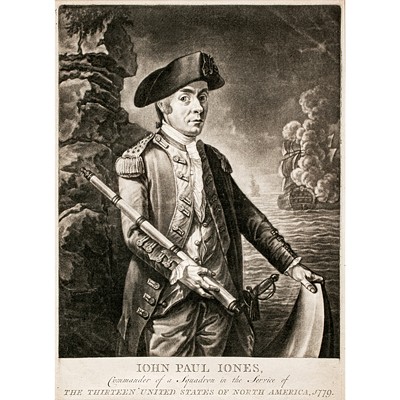c. 1870s Original Oil Painting of Yosemite Valley Attributed to William Harring
Lot 278
Estimate:
$4,000 - $6,000
Absentee vs Live bid
Two ways to bid:
- Leave a max absentee bid and the platform will bid on your behalf up to your maximum bid during the live auction.
- Bid live during the auction and your bids will be submitted real-time to the auctioneer.
Bid Increments
| Price | Bid Increment |
|---|---|
| $0 | $10 |
| $200 | $20 |
| $300 | $25 |
| $500 | $50 |
| $1,000 | $100 |
| $2,000 | $200 |
| $3,000 | $250 |
| $5,000 | $500 |
| $10,000 | $1,000 |
| $20,000 | $2,000 |
| $30,000 | $2,500 |
| $50,000 | $5,000 |
| $100,000 | $10,000 |
| $200,000 | $20,000 |
| $300,000 | $25,000 |
| $500,000 | $50,000 |
About Auction
By Early American History Auctions
Jan 23, 2021
Set Reminder
2021-01-23 12:00:00
2021-01-23 12:00:00
America/New_York
Bidsquare
Bidsquare : Early American History Auction of Autographs, Americana, Political & Maps
https://www.bidsquare.com/auctions/early-american-history-auctions/early-american-history-auction-of-autographs-americana-political-maps-6311
311 Lots of Rare, Historic Autographs, Americana, Civil War Era, George Washington, Abraham Lincoln, Slavery & Black History, Revolutionary War Era, Colonial America, Federal Period, War of 1812, Colonial Currency, Indian Peace Medals & more... Early American History Auctions auctions@earlyamerican.com
311 Lots of Rare, Historic Autographs, Americana, Civil War Era, George Washington, Abraham Lincoln, Slavery & Black History, Revolutionary War Era, Colonial America, Federal Period, War of 1812, Colonial Currency, Indian Peace Medals & more... Early American History Auctions auctions@earlyamerican.com
- Lot Description
Western America
"Yosemite Valley" El Capitan Attributed to San Francisco Artist William Harring, Contemporary of Bierstadt and Hill
c. 1870s Yosemite Valley with a View of El Capitan, Cathedral Spires and Bridal Falls, attributed to San Francisco artist William Harring (1811-1894), Original Oil Painting on Canvas Artwork, California, Framed, Choice Extremely Fine.
A majestic wonderful original oil painting on canvas of the Yosemite Valley, in the "American School" after Albert Bierstadt in the 1860s and prior to Thomas Hill's in 1885. This perfectly positioned rendition has captured most of the "Yosemite Valley" in Yosemite National Park, depicting El Capitan, Cathedral Rocks, Bridal Veil Falls and Merced River plus other topography of the valley's iconic landmarks. It dates from circa 1870s, the third quarter of the 19th century, unsigned, measuring 40.25" x 27.25" set in a attractive gilt-wood frame. The surface has some expected craquelure with some unobtrusive small points retouched. Overall, a handsome alluring original period artwork, drawing the viewer in to the sublime beauty of Yosemite during the 1870s.
Born in Prussia in 1812, William Harring was brought to America by his family, and later worked in Boston for the Louis Prang Company, before settling in San Francisco. He worked there as an oleographer at the Bosqui Printing Company in the 1870s-1890. William Harring is known to have worked as a master lithographer in Boston for the Louis Prang Company before settling in San Francisco where he lived from the 1870s until his death. Harring Exhibited at the San Francisco Art Association, from 1880 to 1883 and Mechanics' Institute, San Francisco in 1880, and at the California State Fair in 1881. (Source: Edan Hughes, "Artists in California, 1786-1940".)
William Harring Von Ammon (1811-1894) Prussian/German-American,simply known as William Harring, was a noted oleographer/chromolithographer, chromographer/chromist (color separator), painter and naturalist known as the "Father of Lithography" in the United States.
Thomas Hill: Born in England, Thomas Hill (1829-1908) immigrated to the United States as a teenager with his parents in 1844. At the age of 24, Hill made the drastic career choice to enroll at the Pennsylvania Academy of Design, studying under the American painter Peter Frederick Rothermel (1812-1895).
It was during his time as a student that Hill began his first trips into the White Mountains of New Hampshire, where he sketched and painted alongside members of the Hudson River School. 1856 saw the opening of Hill's first studio in Boston, but his paintings met with little interest. In the face of economic hardship, Hill and his growing family migrated to the west, settling in California in search of a better climate and economic opportunity.
Once Hill began painting landscapes of the American West, he quickly earned notoriety and in 1865 made his first trip into the ever-stunning Yosemite Valley. Within the year, Hill's images of the valley were earning the artist steady patronage from all across California and the West. Like so many artists who came before and after him, Hill was greatly influenced by the awe-inspiring beauty of the American wilderness.
During his lifetime, Hill's paintings were a huge success and often commanded prices of $10,000. Hill has often been associated and favorably compared to the older generation of American landscape painters, including Albert Bierstadt and Benjamin Champney.
- Shipping Info
-
Early American provides in-house worldwide shipping. Please contact us directly if you have questions about your specific shipping requirements.
-
- Buyer's Premium



 EUR
EUR CAD
CAD AUD
AUD GBP
GBP MXN
MXN HKD
HKD CNY
CNY MYR
MYR SEK
SEK SGD
SGD CHF
CHF THB
THB















